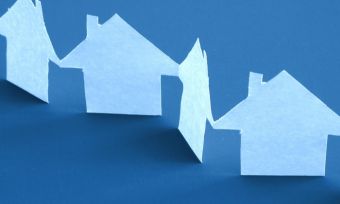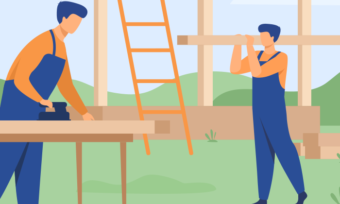How Much to Build a New House in NZ? In this article we cover:
- Median cost of buying an existing house in NZ
- Rising cost of building a new house
- We’re building more, smaller homes
- Hidden costs of building a new home
- Build or buy, which is cheaper?
In 2020, we first published our article: How Much to Build a New House in NZ? Since then, we’ve updated it regularly, and it remains one of the most popular articles on Canstar’s website.
So, over the past five years, how have things changed? Well, one thing remains the same: Auckland is still the most expensive place in NZ to buy property. But the rise in building costs over the past few years has pushed up the cost of building a new home across the entire country. In many places, once you factor in the price of buying a section, purchasing an existing home can often work out cheaper than building a new house.
Median cost of buying an existing house in NZ
As you can see from the data below, median house prices have settled back to where they were at the end of 2020:
| Median Price | Nov 2019 | Nov 2020 | Nov 2021 | January 2025 |
| Auckland | $885,000 | $1,030,000 | $1,300,000 | $949,000 |
| National | $630,000 | $749,000 | $925,000 | $750,000 |
Overall, average median prices over the past two years have remained pretty stable:
Median prices 2024:
- National median price: $780,000 (YoY change: 0%)
- National median price ex Auckland: $697,500 (YoY change: +1%)
- Auckland median price: $1m (YoY change: -0.5%)
While this isn’t good news for those who bought at the market’s peak, in 2021, a softer housing market is good news for those looking to purchase a first home.
Here’s an overview of median prices around the country:
| Region | Median Price January 2025 |
YoY Change |
| Auckland | $949,000 | -2.2% |
| Bay of Plenty | $845,000 | 7.6% |
| Nelson | $840,000 | 25.4% |
| Tasman | $785,000 | -9.8% |
| Wellington | $750,000 | -1.3% |
| Waikato | $749,000 | -3.4% |
| Canterbury | $675,000 | 4.5% |
| Hawke’s Bay | $670,000 | -1.0% |
| Taranaki | $630,000 | -0.3% |
| Northland | $720,000 | -8.3% |
| Otago | $675,000 | -1.1% |
| Marlborough | $668,000 | 0.3% |
| Gisborne | $660,000 | 28.2% |
| Manawatu-Whanganui | $539,000 | 3.1% |
| Southland | $485,000 | 7.2% |
| West Coast | $375,000 | 10.3% |
Cheapest home loan rates
If you’re currently considering a home loan, the table below displays some of the 2-year fixed-rate home loans on our database (some may have links to lenders’ websites) that are available for first home buyers. This table is sorted by Star Rating (highest to lowest), followed by company name (alphabetical). Products shown are principal and interest home loans available for a loan amount of $500K in Auckland. Before committing to a particular home loan product, check upfront with your lender and read the applicable loan documentation to confirm whether the terms of the loan meet your needs and repayment capacity. Use Canstar’s home loan selector to view a wider range of home loan products. Canstar may earn a fee for referrals.
Rising cost of building a new house
While house prices have dropped over the past couple of years, building costs have continued to rise. But price inflation within the construction industry has slowed.
According to the most recent Cordell Construction Cost Index, which measures the costs associated with building a regular 200m² three-bedroom, two-bathroom single-storey brick-and-tile house, over 2024, costs rose by 1.1%.
This figure is down on 2023’s 2.4% increase, and a significant retreat from the double-digit inflation of 10.4% that the building industry experienced over 2022.
Looking at building consent applications over 2024, average construction costs are up 16%, nationally, on 2022’s figures. Although, regionally, there is quite a variance, from 7% in Nelson to 36% in Gisborne.
| Region | $ per m² in 2022 | $ per m² in 2023 | $ per m² in 2024 | % Increase 2022-24 |
| Otago | $3252 | $3536 | $3777 | 16% |
| Gisborne | $2655 | $3065 | $3623 | 36% |
| Bay of Plenty | $2898 | $3437 | $3602 | 24% |
| Wellington | $3072 | $3330 | $3535 | 15% |
| Northland | $2855 | $3520 | $3494 | 22% |
| Hawke’s Bay | $3029 | $3329 | $3419 | 13% |
| Tasman | $2795 | $3154 | $3361 | 20% |
| North Island | $2884 | $3213 | $3333 | 16% |
| Nelson | $3106 | $3132 | $3329 | 7% |
| Auckland | $2908 | $3219 | $3325 | 14% |
| New Zealand | $2820 | $3163 | $3270 | 16% |
| Taranaki | $2583 | $2779 | $3252 | 26% |
| Waikato | $2767 | $3090 | $3146 | 14% |
| South Island | $2661 | $3043 | $3127 | 18% |
| Manawatu-Whanganui | $2650 | $2880 | $3105 | 17% |
| Southland | $2574 | $2756 | $3016 | 17% |
| Marlborough | $2637 | $2842 | $2923 | 11% |
| Canterbury | $2469 | $2900 | $2900 | 17% |
| West Coast | $2538 | $2982 | $2827 | 11% |
Note: it’s important to remember that prices vary build to build, depending on the size and design of a home, and the above figures are estimates based on national building consent applications, which don’t include the full costs of building a new home. For more on the hidden costs of building a new home, see below.
And as building costs per m² have increased so, too, have the average prices of consented new builds in most regions:
| Region | Average new build price 2022 | Average price 2023 | Average price 2024 | % Increase 2022-24 |
| Tasman | $480,654 | $531,429 | $566,015 | 18% |
| Otago | $530,973 | $567,065 | $527,630 | -1% |
| Northland | $487,994 | $546,762 | $508,740 | 4% |
| Taranaki | $433,312 | $435,853 | $491,890 | 14% |
| Southland | $470,940 | $477,653 | $489,725 | 4% |
| Waikato | $441,266 | $449,079 | $476,682 | 8% |
| Hawke’s Bay | $490,519 | $454,320 | $476,476 | -3% |
| Nelson | $447,615 | $417,346 | $463,503 | 4% |
| North Island | $408,319 | $440,995 | $462,854 | 13% |
| Auckland | $393,016 | $434,647 | $462,591 | 18% |
| Bay of Plenty | $453,559 | $447,336 | $457,503 | 1% |
| New Zealand | $408,415 | $441,995 | $457,132 | 12% |
| Marlborough | $469,530 | $452,140 | $450,059 | -4% |
| South Island | $408,668 | $444,605 | $443,848 | 9% |
| Wellington | $369,702 | $431,495 | $441,453 | 19% |
| Manawatu-Whanganui | $440,414 | $420,363 | $427,934 | -3% |
| Gisborne | $317,646 | $380,767 | $425,453 | 34% |
| Canterbury | $365,815 | $406,865 | $406,964 | 11% |
| West Coast | $349,924 | $367,417 | $392,270 | 12% |
We’re building more, smaller homes!
While myriad factors affect the cost of a new build, one thing is clear, we’re building smaller homes. In the early 2000s, we were building fewer homes than in the mid-1970s. However, since then the pace of building has ramped up.
In 2022, the number of new dwellings consented reached a peak of 49,538, up 26% from 2020’s number. But as you can see below, the homes we’re building are getting smaller. Homes built this year are, on average, 9% smaller than those consented back in 2020, and 22% smaller than in 2010.
This has a lot to do with the types of houses we’re building. In the year to June 2020, the majority of new builds (59%) were standalone houses. In 2024, that number dropped to 47%, the majority (53%) being multi-unit housing, such as apartments, townhouses and retirement village units.
| Years | 1974 | 2000 | 2010 | 2020 | 2021 | 2022 | 2023 | 2024 |
|---|---|---|---|---|---|---|---|---|
| NZ homes consented | 39,525 | 25,010 | 28,038 | 39,420 | 49,007 | 49,538 | 37,239 | 33,599 |
| NZ average floor area | 110m2 | 166m2 | 182m2 | 156m2 | 154m2 | 145m2 | 140m2 | 142m2 |
Region to region, while there’s still quite a difference in the size of the houses we’re building, over the past five years, the average size of NZ homes has decreased:
| Region | Average Size 2020 | Average Size 2021 | Average Size 2022 | Average Size 2023 | Average Size 2024 |
| Tasman | 179m2 | 177m2 | 172m2 | 168m2 | 168m2 |
| Southland | 186m2 | 178m2 | 183m2 | 180m2 | 162m2 |
| Marlborough | 192m2 | 193m2 | 178m2 | 175m2 | 154m2 |
| Waikato | 170m2 | 171m2 | 159m2 | 146m2 | 152m2 |
| Taranaki | 168m2 | 164m2 | 168m2 | 154m2 | 151m2 |
| Northland | 180m2 | 177m2 | 171m2 | 156m2 | 146m2 |
| South Island | 167m2 | 161m2 | 154m2 | 150m2 | 142m2 |
| Canterbury | 163m2 | 156m2 | 148m2 | 145m2 | 140m2 |
| New Zealand | 156m2 | 154m2 | 145m2 | 141m2 | 140m2 |
| Otago | 168m2 | 168m2 | 163m2 | 159m2 | 140m2 |
| Auckland | 148m2 | 146m2 | 135m2 | 134m2 | 139m2 |
| Hawke’s Bay | 158m2 | 148m2 | 162m2 | 137m2 | 139m2 |
| Nelson | 167m2 | 162m2 | 144m2 | 138m2 | 139m2 |
| North Island | 152m2 | 153 m2 | 142m2 | 137m2 | 139m2 |
| West Coast | 159m2 | 151m2 | 138m2 | 126m2 | 139m2 |
| Manawatu-Whanganui | 164m2 | 172m2 | 166m2 | 148m2 | 138m2 |
| Bay of Plenty | 154m2 | 157m2 | 156m2 | 131m2 | 127m2 |
| Wellington | 133m2 | 132m2 | 120m2 | 132m2 | 125m2 |
| Gisborne | 175m2 | 132m2 | 120m2 | 124m2 | 117m2 |
Searching for the Cheapest Personal Loan?
If you’re looking for the cheapest personal loan, Canstar’s personal loan comparison tables can help. The table below displays the sponsored unsecured personal loan products available on Canstar’s database for a three-year loan of $10,000 in Auckland, with links to lenders’ websites. Use Canstar’s personal loan comparison selector to view a wider range of products on Canstar’s database. Canstar may earn a fee for referrals.
Hidden costs of building a new home
However, even without building cost inflation, when pricing a new build, there are other factors involved that can push up costs.
“When most architects and designers submit building consent applications the build value figure we put in is as low as possible, to keep the consent costs down. Because the value of the build impacts the consent fee,” says Trent Simpkin, of Arcline Architecture.
“Yes, it could be considered inaccurate, but councils should only need to know the value of the consentable items. So, for example, if we say a house is $3000 per m² on a consent application, in reality, it’s more of a $4000 per m² build.
“The shape and circumference of a home are big players in the cost of the build, too. A square house has the least perimeter of any shape, so is the cheapest to build, as it requires less cladding, insulation, roofing, etc. Whereas a house the same size split into individual pods will cost more.”
If you’re trying to keep costs down, Trent advises to avoid the following, which could push the cost of your build well over $4000 per m².
- Elevated sites, exposed to the wind
- Steep (or even not so steep) sites that require retaining walls
- Unsuitable ground requiring engineering design
- Large square metres of glass (requiring steel portals)
- Open expanses of living areas (requiring engineering due to lack of walls to brace)
- Cantilevered decks, roofs, floors
- Expensive cladding, like cedar, and roofing, such as tray roofing
- Difficult site access
- Any build methods that are time consuming
Build or to buy? Which is cheaper?
Before we start the sums, let’s just make it clear that we’re talking about averages here. Construction costs, the price of existing properties, and land prices vary from region to region, suburb to suburb and house to house.
But it’s clear that the rise in construction costs has pushed up the price of new builds to a level where they are comparable, and often more expensive, than buying existing homes once you factor in the cost of land.
The most recent government report into land prices reveals that in Auckland, back in 2021, urban-zoned land was valued at around $1300 per m², in Tauranga it was $1100 per m², while in Wellington, Hamilton and Queenstown prices ranged between $400-$500 per m².
The median point in these numbers is around $850 per m². So let’s say the average price is $800 per m², because when applied to a typical 500 per m² section, it works out to a cost of $400,000 for an average NZ section.
So if you add the average cost of building a home in NZ ($457,132) to the cost of an average section ($400,000), you get: $857,132.
And what was the national median house price according to REINZ? Yep, around $780,000 – so, yes, buying a section and building a new home on it could well end up costing you considerably more than just buying an average existing home.
Although, at least if you buy a new property, you shouldn’t have to worry about renovation or upkeep costs for a few years!
Lowest construction loans
If you’re considering a new build, big or small, wherever you are in the country, it’s worth reading our story What is a Construction Home Loan. For as you’ll see, the structure of a loan to build a new home is usually different to a standard home loan, and usually feature floating rates during the construction stage.
If you’re currently considering a home loan, the table below displays some of the floating home loans on our database (some may have links to lenders’ websites) that are available for home owners looking to refinance. This table is sorted by Star Rating (highest to lowest), followed by company name (alphabetical). Products shown are principal and interest home loans available for a loan amount of $500K in Auckland. Before committing to a particular home loan product, check upfront with your lender and read the applicable loan documentation to confirm whether the terms of the loan meet your needs and repayment capacity. Use Canstar’s home loan selector to view a wider range of home loan products. Canstar may earn a fee for referrals.
About the author of this page
Bruce Pitchers is Canstar NZ’s Content Manager. An experienced finance reporter, he has three decades’ experience as a journalist and has worked for major media companies in Australia, the UK and NZ, including ACP, Are Media, Bauer Media Group, Fairfax, Pacific Magazines, News Corp and TVNZ. As a freelancer, he has worked for The Australian Financial Review, the NZ Financial Markets Authority and major banks and investment companies on both sides of the Tasman.
In his role at Canstar, he has been a regular commentator in the NZ media, including on the Driven, Stuff and One Roof websites, the NZ Herald, Radio NZ, and Newstalk ZB.
Away from Canstar, Bruce creates puzzles for magazines and newspapers, including Woman’s Day and New Idea. He is also the co-author of the murder-mystery puzzle book 5 Minute Murder.







Share this article